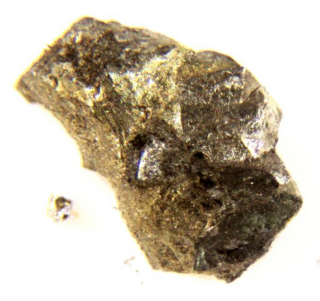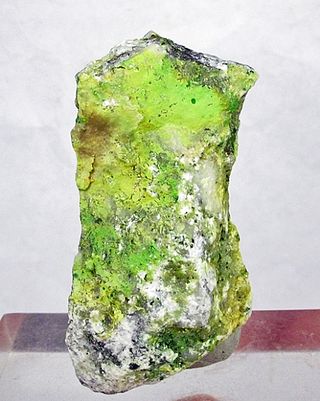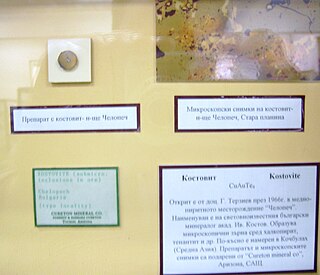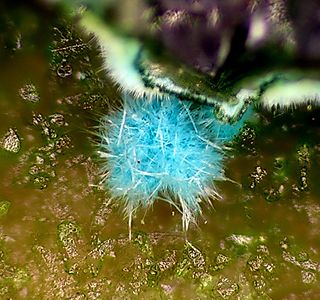
Auricupride is a natural alloy that combines copper and gold. Its chemical formula is Cu3Au. The alloy crystallizes in the cubic crystal system in the L12 structure type and occurs as malleable grains or platey masses. It is an opaque yellow with a reddish tint. It has a hardness of 3.5 and a specific gravity of 11.5.

Uvarovite is a chromium-bearing garnet group species with the formula: Ca3Cr2(SiO4)3. It was discovered in 1832 by Germain Henri Hess who named it after Count Sergei Semenovitch Uvarov (1765–1855), a Russian statesman and amateur mineral collector. It is classified in the ugrandite group alongside the other calcium-bearing garnets andradite and grossular.

Moolooite is a rare blue-green mineral with the formula Cu++(C2O4)·n(H2O) (n<1) (copper oxalate hydrate). It was discovered by Richard M Clarke and Ian R Williams in Bunbury Well, Mooloo Downs station, Murchison, Western Australia in 1986. It has an orthorhombic crystalline structure, and is formed by the interaction of bird guano with weathering copper sulfides. It is used in plastics to color them blueish-green.

Adamite is a zinc arsenate hydroxide mineral, Zn2AsO4OH. It is a mineral that typically occurs in the oxidized or weathered zone above zinc ore occurrences. Pure adamite is colorless, but usually it possess yellow color due to Fe compounds admixture. Tints of green also occur and are connected with copper substitutions in the mineral structure. Olivenite is a copper arsenate that is isostructural with adamite and there is considerable substitution between zinc and copper resulting in an intermediate called cuproadamite. Zincolivenite is a recently discovered mineral being an intermediate mineral with formula CuZn(AsO4)(OH). Manganese, cobalt, and nickel also substitute in the structure. An analogous zinc phosphate, tarbuttite, is known.

Olivenite is a copper arsenate mineral, formula Cu2AsO4OH. It crystallizes in the monoclinic system (pseudo-orthorhombic), and is sometimes found in small brilliant crystals of simple prismatic habit terminated by domal faces. More commonly, it occurs as globular aggregates of acicular crystals, these fibrous forms often having a velvety luster; sometimes it is lamellar in structure, or soft and earthy.

Rickardite is a telluride mineral, a copper telluride (Cu7Te5) or Cu3-x (x = 0 to 0.36)Te2. It was first described for an occurrence in the Good Hope Mine, Vulcan district, Gunnison County, Colorado, US, and named for mining engineer Thomas Arthur Rickard (1864–1953). It is a low temperature hydrothermal mineral that occurs associated with vulcanite, native tellurium, cameronite, petzite, sylvanite, berthierite, pyrite, arsenopyrite and bornite.

Kinoite is a light blue copper silicate mineral. It is somewhat scarce. It has a monoclinic crystal system, vitreous luster, and is transparent to translucent. It can be found in the Santa Rita Mountains, the Christmas Mine at Christmas, Arizona and a few other copper mines. Kinoite is popular with mineral collectors. Kinoite was named upon its discovery in 1970 after the pioneer Jesuit missionary Padre Eusebio Kino who worked in Arizona, Sonora and Baja California.
Frankhawthorneite Cu2Te6+O4(OH)2 is a monoclinic copper tellurate mineral (space group P21/n) named after Prof. Frank Christopher Hawthorne (born 1946), University of Manitoba, Winnipeg, Canada. It was discovered at Centennial Eureka Mine, Tintic District, East Tintic Mountains, Juab County, Utah, in 1995. It has a leaf green color.

Vulcanite is a rare copper telluride mineral. The mineral has a metallic luster, and has a green or bronze-yellow tint. It has a hardness between 1 and 2 on the Mohs scale. Its crystal structure is orthorhombic.

Xocomecatlite is a rare tellurate mineral with formula: Cu3(TeO4)(OH)4. It is an orthorhombic mineral which occurs as aggregates or spherules of green needlelike crystals.

Aktashite is a rare arsenic sulfosalt mineral with formula Cu6Hg3As4S12. It is a copper mercury-bearing sulfosalt and is the only sulfosalt mineral with essential Cu and Hg yet known. It is of hydrothermal origin. It was published without approval of the IMA-CNMNC, but recognized as valid species by the IMA-CNMNC Sulfosalts Subcommittee (2008).

Anthonyite is a hydrous secondary copper halide mineral with chemical formula of Cu(OH,Cl)2·3(H2O).

Gilalite is a copper silicate mineral with chemical composition of Cu5Si6O17·7(H2O).

Utahite is an extremely rare secondary copper zinc tellurate mineral found as a product of oxidation. Its chemical formula is Cu5Zn3(Te6+O4)4(OH)8•7H2O.

Kostovite is a rare orthorhombic-pyramidal gray white telluride mineral containing copper and gold with chemical formula AuCuTe4.

Strashimirite is a rare monoclinic mineral containing arsenic, copper, hydrogen, and oxygen. It has the chemical formula Cu8(AsO4)4(OH)4·5(H2O).
Daubréeite is a rare bismuth oxohalide mineral with formula BiO(OH,Cl). It is a creamy-white to yellow-brown, soft, earthy clay–like mineral which crystallizes in the tetragonal crystal system. It is a member of the matlockite group.

Tlapallite is a rare and complex tellurate mineral with the chemical formula (Ca,Pb)3CaCu6[Te4+3Te6+O12]2(Te4+O3)2(SO4)2·3H2O. It has a Moh's hardness of 3 and it is green in colour. It was named after the Nahua word "Tlalpalli", which translates to paint, referring to the paint-like habit of the mineral. Its formula and crystal structure were redefined in 2019, showing it contained a mixed-valence phyllotellurate layer [Te4+3Te6+O12]12−.

Tlalocite is a rare and complex tellurate mineral with the formula Cu10Zn6(TeO4)2(TeO3)(OH)25Cl · 27 H2O. It has a Mohs hardness of 1, and a cyan color. It was named after Tlaloc, the Aztec god of rain, in allusion to the high amount of water contained within the crystal structure. It is not to be confused with quetzalcoatlite, which often looks similar in color and habit.

Quetzalcoatlite is a rare tellurium oxysalt mineral with the formula Zn6Cu3(TeO6)2(OH)6 · AgxPbyClx+2y. It also contains large amounts of silver- and lead(II)chloride with the formula AgxPbyClx+2y (x+y≤2). It has a Mohs hardness of 3 and it crystallizes in the trigonal system. It has a deep blue color. It was named after Quetzalcoatl, the Aztec and Toltec god of the sea, alluding to its color. It is not to be confused with tlalocite, which has a similar color and habit.


















